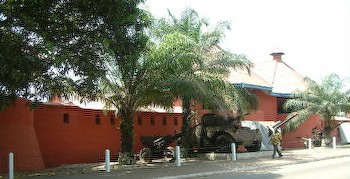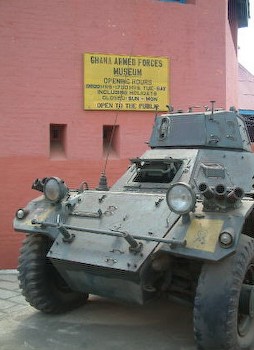|
 Fort
Kumasi rebuilt by the British in 1896/1897 to replace the Asante fort.
(opposite the Central Post Office) Destroyed during the Anglo-Ashanti Wars
(a series of four wars) between the British and the Ashanti Confederacy in
1826, 1873, 1893-1894 and 1895-1896.) Now the GHANA ARMED FORCES MUSEUM Fort
Kumasi rebuilt by the British in 1896/1897 to replace the Asante fort.
(opposite the Central Post Office) Destroyed during the Anglo-Ashanti Wars
(a series of four wars) between the British and the Ashanti Confederacy in
1826, 1873, 1893-1894 and 1895-1896.) Now the GHANA ARMED FORCES MUSEUM
"British school history books only talk
about two wars between the Asantes and the British colonialists, in which
the British won, - but it is interesting to learn that there were hundreds
of wars in which the British lost to the Asantes.”
 The Museum - founded in
1952 -exhibits materials that primarily concern the British-Ashanti war of
1900, World War II + I and Ghanas Recent military history. On display are
maps, old photographs, and military regalia. Located in Kumasi in the Asante
Region is one of the very few Military Museums in Africa. It has been an
institution of learning primarily about the evolution and development of the
Gold Coast Regiment of the Colonial era to the present Ghana. The Museum - founded in
1952 -exhibits materials that primarily concern the British-Ashanti war of
1900, World War II + I and Ghanas Recent military history. On display are
maps, old photographs, and military regalia. Located in Kumasi in the Asante
Region is one of the very few Military Museums in Africa. It has been an
institution of learning primarily about the evolution and development of the
Gold Coast Regiment of the Colonial era to the present Ghana.
The present building is the second built
on the site. The first building was known as the Kumasi Fort and was built
in 1820 by the Asantehene Osei Tutu Kwamina who wanted a replica of the Cape
Coast forts built by the European merchants. Building materials such as
granite and the brown soil were brought from Cape Coast to Kumasi by head
porters as it was intended to be similar to the Castle in Cape Coast. The
fort was destroyed during the Asante wars in 1874 by the British forces and
was reconstructed two more than 20 years later with a Residency attached for
the occupation by the District Commissioner.
 The building was completed in 1897.After World War II, the British Colonial
Government decided to find a place to store artifacts used or seized during
the World War I (German Togoland) and II, the Abyssinia Campaign and the
Asante wars. These artifacts were kept at the Quartermaster Stores of the
various Units of the Army. The building was completed in 1897.After World War II, the British Colonial
Government decided to find a place to store artifacts used or seized during
the World War I (German Togoland) and II, the Abyssinia Campaign and the
Asante wars. These artifacts were kept at the Quartermaster Stores of the
various Units of the Army.
A Peace Keeping Hall marks the participation of Ghana in Peace Keeping
Operations since the Congo Crisis in 1960. In all there are nine exhibition
halls housing over two thousand artifacts.
|